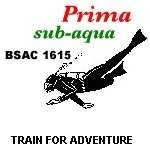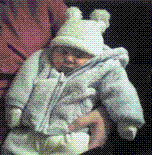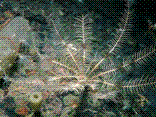
Issue 5 April 2007
Off-Gassing...
(Web Version)
Welcome to the fifth issue of our newsletter.
Thanks to all who attended the DIVERS FORUM on 3rd April at the Woodman. If you have any other suggestions please let us know.
MULL & HARRIS 22nd - 30th June 2007
Ryan, Born 22nd Feb made his first visit to the club on 27th February.

& attended first dive on 8th April!
Saturday and Sunday will be spent diving
old favourites in the Sound of Mull and perhaps the 'Falls of Lora' (an
underwater waterfall). Monday we travel to Harris diving on the way. I
couldn't find any data on specific dive sites, except for the wreck of
the 1685-ton Panamanian steamship
"Stassa", still intact (with a crow's
nest) and the subject of a divernet wreck tour, however the general
information is mouth watering.
The Outer Hebrides lie 20 miles off the West Coast of Scotland,
generally low lying but Harris is
mountainous with hills rising to somewhere in the region of 3,000 feet.
An advantage of this coastline is that there is almost always a
sheltered shore from which to dive. The rich clear waters, free from
pollution, with visibility of 20-30 metres in the summertime, are warmed
by the Gulf Stream and are full of marine life, including ling, conger,
shoaling fish, lobster, crayfish, cuttlefish, octopus and seals. The
literally hundreds of dive sites in the area cannot fail to impress,
dives range from huge caverns, to spectacular caves simply teeming with
fish, wrecks covered with soft corals and anemones, and some of the most
terrific vertical walls. If you are not under the water these islands
boast some of the world's most stunning golden beaches. The wildlife
sightings register for
the week in June last year reported 3 white tailed eagles, 8 pods of dolphins, 1 pod of 40 - 60 beaked dolphins reportedly bow riding for 40 minutes, 6 minke whales, 5 killer whales & one 10 metre basking shark.
Seasearch - Course 3rd March 2007
10 litre Cylinder. In test
£50 contact: Richard Mace
0121 232 6007
If you have any items for sale please let us know.
Seasearch is a project for recreational divers who want to do their bit for the marine environment by collecting information about the marine habitats, plants and animals that only divers see. We can carry out Seasearch dives with our club, buddy or organised Seasearch weekends. The initial part of the Seasearch course was not as I expected it to be, the lecturer dealt more with how to record what you observed rather than instructing on how to identify the items we see under water. This does not mean that I did not find the lecturer interesting or instructive, far from it, it was both. We were taught how to recognise the main underwater habitat types and a small number of species, and to record these on the straight forward Seasearch Observation Forms.Check:-www.seasearch.org.uk
Wreck of the Month. Aeolian Sky
Editors Corner
Thank you to everyone who has contributed to this months issue, and
apologies for any mistakes.
Any further articles for next months edition would be appreciated, (any gossip, scandals, etc that’s printable) so let us know by 20th April.
Hope you enjoyed this issue.
The wreck lies on a 30m deep seabed on its portside, with the upper deck at 20m. Even though it is a modern wreck it has still deteriorated causing the holds to collapse to half their original width. Most of the superstructure at the stern is intact and now covered in soft anemones. For those of the ferreting persuasion the superstructure has a lot of swim throughs, access to the companion ways and cabins is easy, however more advanced divers can penetrate to the engine room which is also at the stern (use a reel?). Entrance to engine room can be gained via a break near the funnel or through holes near the prop shaft, this route gives a nice dive up through the engine room and out the superstructure.
For those not interested in penetration there is loads to see on the outside including a winch on the stern deck, rudder, unfortunately no prop. In the holds are land rovers, dumper trucks. The main sites along the holds are the masts and cargo derricks, these are huge! The bow is intact and the starboard anchor still in place.
Simply this is a huge wreck which really needs more than one dive to see fully. A tip for this wreck, due to its depth using Nitrox 32% gives a major advantage at avoiding deco and still getting a decent length dive.
Feather Stars
 Feather
stars belong to a group of animals called echinoderms – meaning
'Spiny skinned'. Other family members include starfish, brittle
stars, sea urchins & sea cucumbers.
Feather
stars belong to a group of animals called echinoderms – meaning
'Spiny skinned'. Other family members include starfish, brittle
stars, sea urchins & sea cucumbers.The feather stars have 5 paired arms which branch from a cup-shaped body. The arms are used for filter feeding, on plankton, and mobility.
Feather stars can crawl, roll, walk and even swim but usually they cling to sponges or corals. They are primarily nocturnal but they are seen in the open during the day with their arms rolled up.
The feather stars mouth and anus are found on the upper surface of the animal and underneath are a number of short appendages, called cirri, which are used for gripping.
The elegant feather star (Antedon petasus) is usually found in sheltered habitats attached to kelp, sessile animals, wrecks or boulders. They can be found in moderately exposed habitats. They are usually found at depths from about 20 metres to several hundred metres.
The elegant feather star is larger than the feather star Antedon bifida and has a neater appearance, hence the name elegant. It is also has different coloration. Elegant feather stars typically have 10 arms. The arms are either brown or red and white with the colour in large patches, as seen in the photograph where the colours appear as bands, rather than the freckled appearance of Antedon bifida. The arms are typically 7-10cm in length
Although Antedon petasus is less common than Antedon bifidathey are found in similar locations. Antedon petasus is more dominant in northern deep waters
In the British Isles, Antedon petasus is found in northerly regions at least in shallow water, it is also frequently found in the northern part of the Irish Sea and inshore in the west of Scotland and around Shetland